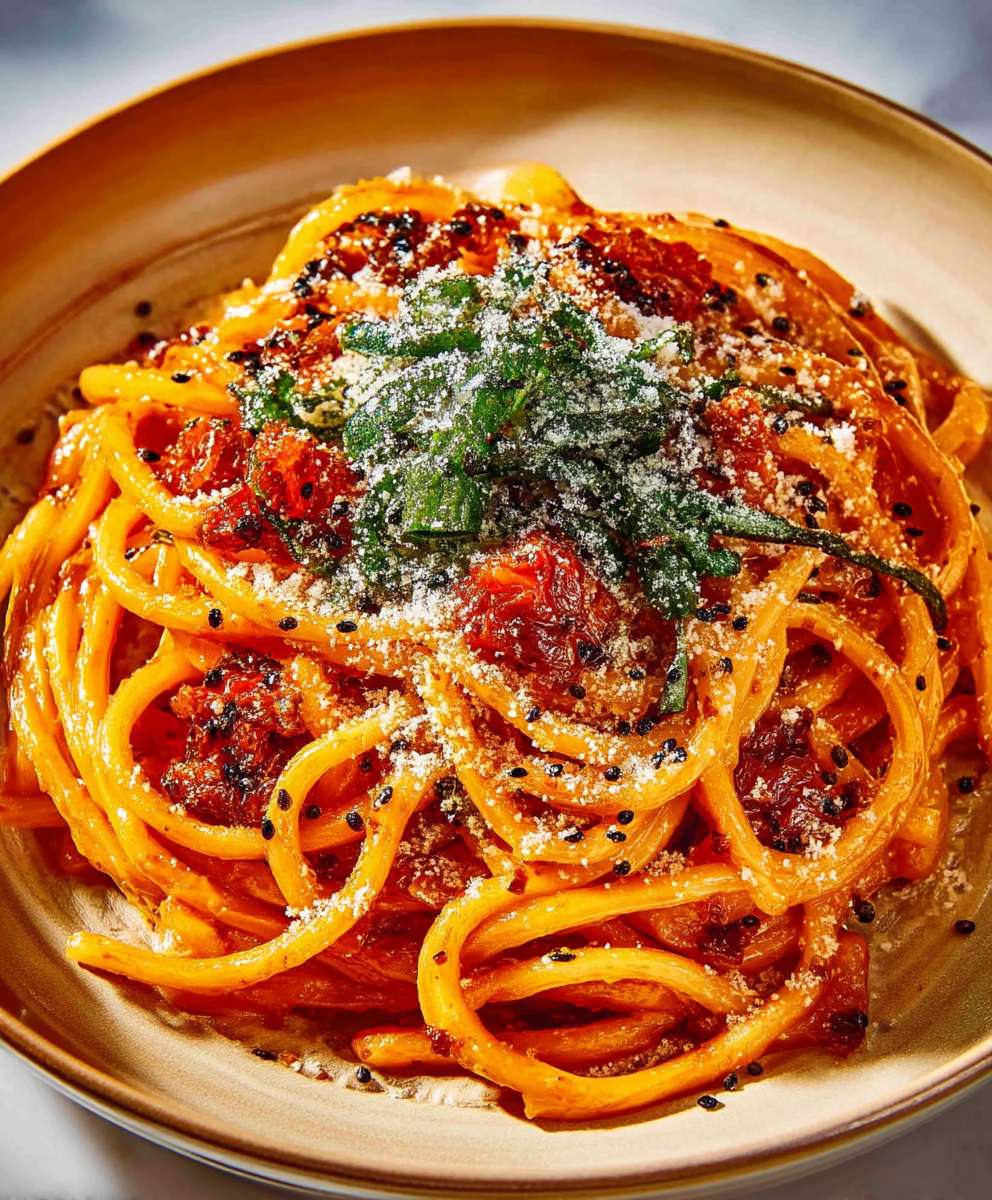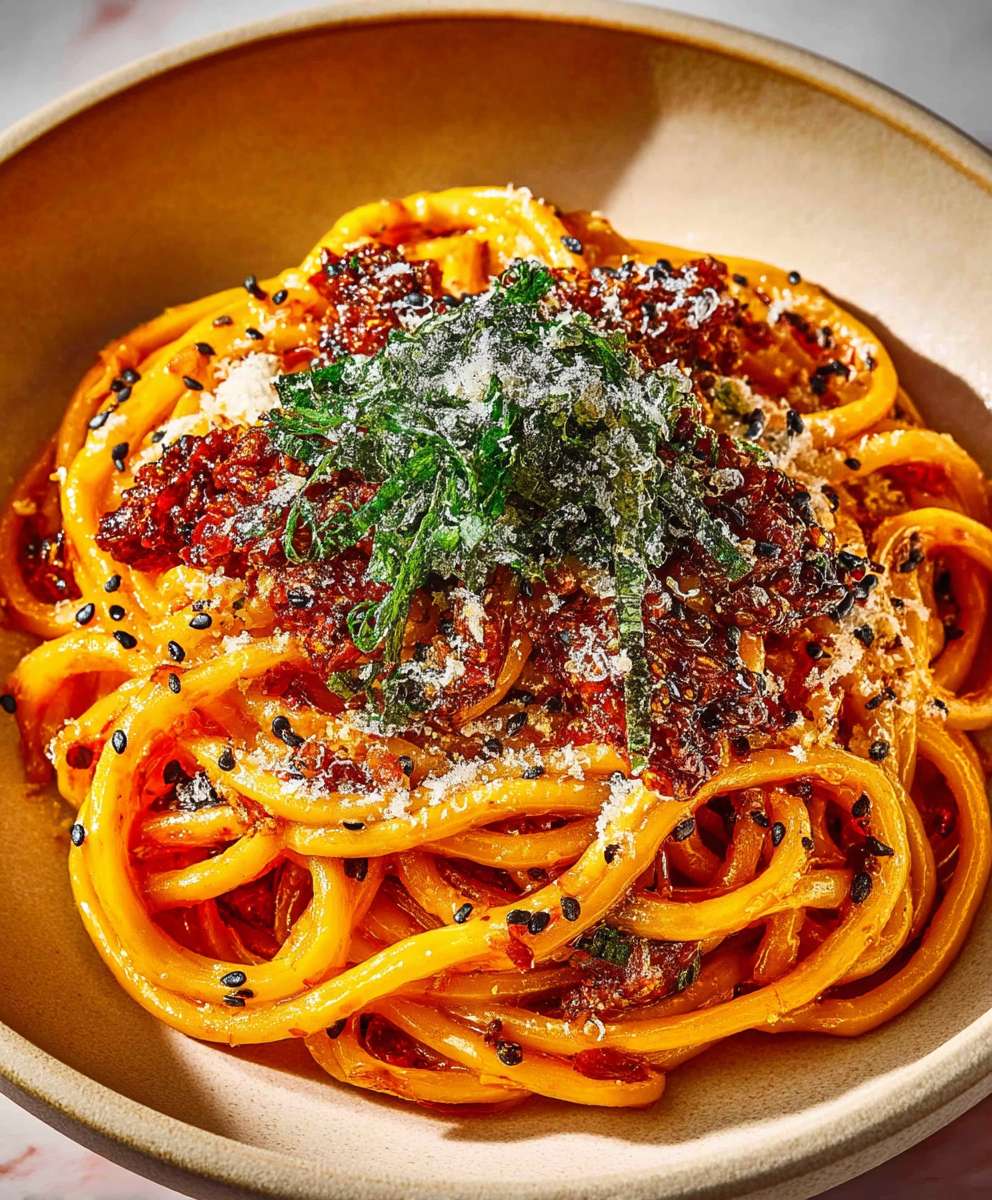Gochujang Noodles: Prepare to embark on a flavor adventure that will tantalize your taste buds and leave you craving more! Imagine a symphony of savory, spicy, and slightly sweet notes dancing on your palate. That’s precisely what awaits you with this incredibly easy and satisfying noodle dish.
Gochujang, the star of this recipe, is a fermented Korean chili paste that has been a staple in Korean cuisine for centuries. Its rich, complex flavor profile adds depth and character to countless dishes. While its exact origins are debated, gochujang’s use can be traced back to the Joseon Dynasty, where it was a prized ingredient in royal kitchens and humble homes alike. Today, it’s a global sensation, loved for its unique umami and fiery kick.
What makes Gochujang Noodles so irresistible? It’s the perfect balance of flavors and textures. The chewy noodles, coated in a luscious gochujang-based sauce, offer a delightful mouthfeel. The heat from the gochujang is tempered by the sweetness of honey or sugar, creating a harmonious blend that’s both comforting and exciting. Plus, this recipe is incredibly versatile and quick to prepare, making it ideal for busy weeknights or when you’re simply craving a delicious and satisfying meal. Whether you’re a seasoned cook or a kitchen novice, you can easily whip up a batch of these flavorful noodles in under 30 minutes. So, let’s get cooking and discover the magic of gochujang!
Ingredients:
- Noodles: 8 ounces dried noodles (spaghetti, udon, or ramen work well)
- Gochujang Sauce:
- 2 tablespoons gochujang (Korean chili paste)
- 1 tablespoon soy sauce
- 1 tablespoon rice vinegar
- 1 tablespoon honey or maple syrup (adjust to taste)
- 1 tablespoon sesame oil
- 1 clove garlic, minced
- 1/2 teaspoon ginger, grated
- 1-2 tablespoons water (to thin the sauce, if needed)
- Protein (optional):
- 4 ounces ground pork, beef, or chicken
- OR 4 ounces tofu, cubed
- OR 1 cup cooked shrimp
- Vegetables:
- 1 cup shredded carrots
- 1 cup sliced cucumber
- 1 cup bean sprouts
- 1/2 cup chopped scallions
- 1/4 cup chopped kimchi (optional)
- Garnish:
- Sesame seeds
- Chopped cilantro or parsley
- Fried egg (optional)
- Sriracha (optional, for extra heat)
Preparing the Gochujang Sauce:
Alright, let’s get started by making the heart of this dish the gochujang sauce! This is where all the magic happens, and it’s super easy to whip up.
-
Combine the ingredients: In a medium bowl, whisk together the gochujang, soy sauce, rice vinegar, honey (or maple syrup), sesame oil, minced garlic, and grated ginger. Make sure everything is well combined and there are no clumps of gochujang.
-
Adjust the consistency: If the sauce seems too thick, add water one tablespoon at a time until it reaches your desired consistency. I usually aim for a sauce that’s easily pourable but still clings nicely to the noodles.
-
Taste and adjust: This is crucial! Give the sauce a taste and adjust the flavors to your liking. If you want it sweeter, add a little more honey or maple syrup. For more tang, add a splash of rice vinegar. If you like it spicier, add a pinch of red pepper flakes or a dash of sriracha. Remember, you’re the chef here, so make it your own!
-
Set aside: Once you’re happy with the sauce, set it aside while you prepare the other components of the dish. The flavors will meld together even more as it sits.
Cooking the Protein (Optional):
If you’re adding protein to your gochujang noodles, now’s the time to cook it. This step is totally optional, so feel free to skip it if you’re going for a vegetarian or vegan version. Tofu works great too!
-
Prepare the protein: If using ground meat, break it up into small pieces. If using tofu, press it to remove excess water and then cube it. If using shrimp, make sure it’s peeled and deveined.
-
Cook the protein: Heat a tablespoon of oil (vegetable, canola, or sesame oil) in a skillet or wok over medium-high heat. Add the protein and cook until it’s fully cooked through. Ground meat should be browned, tofu should be golden brown, and shrimp should be pink and opaque.
-
Season the protein: While the protein is cooking, season it with a pinch of salt and pepper. You can also add a little bit of garlic powder or onion powder for extra flavor. If you want to add a little extra kick, you can even toss in a small amount of the gochujang sauce towards the end of the cooking process.
-
Set aside: Once the protein is cooked, remove it from the skillet and set it aside. We’ll add it to the noodles later.
Cooking the Noodles:
Now, let’s get those noodles cooked to perfection! The type of noodles you use is totally up to you. Spaghetti, udon, or ramen noodles all work great. Just follow the package instructions for cooking times.
-
Boil water: Bring a large pot of salted water to a rolling boil. The salt helps to season the noodles as they cook.
-
Cook the noodles: Add the noodles to the boiling water and cook according to the package instructions. Be careful not to overcook them, as they’ll become mushy. You want them to be al dente, which means they’re still slightly firm to the bite.
-
Drain the noodles: Once the noodles are cooked, drain them immediately in a colander. Don’t rinse them unless you’re using a type of noodle that tends to stick together. Rinsing can remove some of the starch, which helps the sauce cling to the noodles.
Assembling the Gochujang Noodles:
Alright, we’re in the home stretch! Now it’s time to bring everything together and create our delicious gochujang noodles.
-
Combine noodles and sauce: In a large bowl, combine the cooked noodles and the gochujang sauce. Toss everything together until the noodles are evenly coated with the sauce. Make sure every strand is glistening with that flavorful goodness!
-
Add protein (optional): If you cooked protein, add it to the bowl and toss it with the noodles and sauce. Make sure the protein is evenly distributed throughout the dish.
-
Add vegetables: Add the shredded carrots, sliced cucumber, bean sprouts, chopped scallions, and kimchi (if using) to the bowl. Toss everything together gently until the vegetables are evenly distributed. I like to add the vegetables last so they retain their crispness.
-
Serve immediately: Serve the gochujang noodles immediately in bowls. Garnish with sesame seeds, chopped cilantro or parsley, and a fried egg (if desired). You can also add a drizzle of sriracha for extra heat.
Tips and Variations:
Here are a few extra tips and variations to help you customize your gochujang noodles to your liking:
-
Adjust the spice level: Gochujang can be quite spicy, so adjust the amount you use according to your spice preference. If you’re sensitive to heat, start with a smaller amount and add more to taste. You can also use a milder gochujang paste.
-
Add more vegetables: Feel free to add other vegetables to your gochujang noodles, such as bell peppers, mushrooms, spinach, or bok choy. Just make sure to cook them before adding them to the noodles.
-
Make it vegan: To make this dish vegan, use tofu as the protein source and substitute honey with maple syrup or agave nectar. You can also use a vegan gochujang paste, as some brands contain fish sauce.
-
Add a fried egg: A fried egg adds richness and creaminess to the dish. Simply fry an egg to your liking and place it on top of the noodles before serving.
-
Make it ahead of time: You can prepare the gochujang sauce and cook the protein ahead of time. Store them separately in the refrigerator until you’re ready to assemble the dish. Cook the noodles just before serving to prevent them from becoming mushy.
-
Use different noodles: Experiment with different types of noodles to find your favorite. Soba noodles, glass noodles, or even zucchini noodles (for a low-carb option) would all work well.
-
Add a squeeze of lime: A squeeze of fresh lime juice adds a bright and tangy flavor to the dish.
-
Don’t be afraid to

Conclusion:
So there you have it! These Gochujang Noodles are truly a flavor explosion you won’t want to miss. The perfect balance of spicy, savory, and slightly sweet makes them incredibly addictive, and the quick preparation time makes them ideal for busy weeknights or a satisfying lunch. I honestly believe this recipe is a game-changer for anyone looking to add a little excitement to their noodle routine.
But why is this recipe a must-try? Beyond the incredible taste, it’s the versatility that really shines. You can easily adapt it to your preferences and what you have on hand. Feeling extra hungry? Add a fried egg on top for some protein and richness. Want to load up on veggies? Sauté some bell peppers, mushrooms, or spinach and toss them in with the noodles. The possibilities are endless!
Serving Suggestions and Variations:
For a complete meal, consider serving these Gochujang Noodles with a side of kimchi or a refreshing cucumber salad. The cool, crisp flavors will complement the spiciness of the noodles perfectly. You could also add some grilled chicken or tofu for extra protein.
Here are a few variations to get you started:
* Spicy Level Adjustment: If you’re sensitive to spice, start with a smaller amount of gochujang and add more to taste. You can also add a touch of honey or maple syrup to balance the heat.
* Protein Power: As mentioned before, a fried egg is a classic addition. But you could also try adding shredded chicken, ground pork, or even some crispy tofu.
* Veggie Boost: Don’t be afraid to load up on the vegetables! Broccoli, carrots, zucchini, and bean sprouts all work wonderfully in this dish.
* Noodle Swap: While I love using udon noodles for their chewy texture, you can easily substitute them with other types of noodles, such as ramen, spaghetti, or even rice noodles. Just adjust the cooking time accordingly.
* Seafood Sensation: Add some shrimp or scallops for a delicious seafood twist. Sauté them separately and then toss them in with the noodles.I’ve personally made this recipe countless times, and I’m always amazed at how quickly it comes together and how satisfying it is. It’s become a staple in my kitchen, and I have a feeling it will become one in yours too.
Ready to Get Cooking?
I truly hope you give these Gochujang Noodles a try. I’m confident that you’ll love them as much as I do. And remember, cooking is all about experimentation and having fun! So don’t be afraid to get creative and put your own spin on the recipe.
Once you’ve made them, I’d absolutely love to hear about your experience. Did you make any modifications? What did you serve them with? What did your family and friends think? Share your photos and stories in the comments below! I’m always looking for new ideas and inspiration, and I can’t wait to see what you come up with. Happy cooking, and enjoy your delicious Gochujang Noodles!
Gochujang Noodles: A Spicy & Delicious Recipe You'll Love
Spicy and flavorful Gochujang Noodles with your choice of protein and fresh vegetables, tossed in a homemade Korean chili paste sauce.
Ingredients
- 8 ounces dried noodles (spaghetti, udon, or ramen work well)
- 2 tablespoons gochujang (Korean chili paste)
- 1 tablespoon soy sauce
- 1 tablespoon rice vinegar
- 1 tablespoon honey or maple syrup (adjust to taste)
- 1 tablespoon sesame oil
- 1 clove garlic, minced
- 1/2 teaspoon ginger, grated
- 1-2 tablespoons water (to thin the sauce, if needed)
- 4 ounces ground pork, beef, or chicken
- OR 4 ounces tofu, cubed
- OR 1 cup cooked shrimp
- 1 cup shredded carrots
- 1 cup sliced cucumber
- 1 cup bean sprouts
- 1/2 cup chopped scallions
- 1/4 cup chopped kimchi (optional)
- Sesame seeds
- Chopped cilantro or parsley
- Fried egg (optional)
- Sriracha (optional, for extra heat)
Instructions
- Prepare the Gochujang Sauce: In a medium bowl, whisk together the gochujang, soy sauce, rice vinegar, honey (or maple syrup), sesame oil, minced garlic, and grated ginger. Add water, 1 tablespoon at a time, until the sauce reaches your desired consistency. Taste and adjust flavors as needed (more honey for sweetness, rice vinegar for tang, sriracha for spice). Set aside.
- Cook the Protein (Optional): Heat a tablespoon of oil in a skillet or wok over medium-high heat. Add your chosen protein (ground meat, tofu, or shrimp) and cook until fully cooked through. Season with salt, pepper, and optional garlic/onion powder. You can also add a small amount of the gochujang sauce towards the end of the cooking process. Set aside.
- Cook the Noodles: Bring a large pot of salted water to a rolling boil. Add the noodles and cook according to package instructions until al dente. Drain immediately in a colander.
- Assemble the Noodles: In a large bowl, combine the cooked noodles and the gochujang sauce. Toss until the noodles are evenly coated.
- Add Protein (Optional): If you cooked protein, add it to the bowl and toss it with the noodles and sauce.
- Add Vegetables: Add the shredded carrots, sliced cucumber, bean sprouts, chopped scallions, and kimchi (if using) to the bowl. Toss gently until the vegetables are evenly distributed.
- Serve: Serve the gochujang noodles immediately in bowls. Garnish with sesame seeds, chopped cilantro or parsley, and a fried egg (if desired). Add a drizzle of sriracha for extra heat.
Notes
- Spice Level: Adjust the amount of gochujang to your spice preference.
- Vegetable Variations: Add other vegetables like bell peppers, mushrooms, spinach, or bok choy.
- Vegan Option: Use tofu, maple syrup/agave, and vegan gochujang paste.
- Make Ahead: Prepare the sauce and protein ahead of time. Cook noodles just before serving.
- Noodle Variations: Experiment with soba noodles, glass noodles, or zucchini noodles.
- Lime Juice: A squeeze of fresh lime juice adds a bright and tangy flavor.

